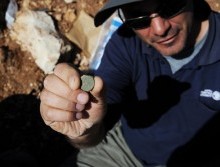
Pablo Betzer, IAA District Archaeologist for Judah, with a coin from the Year Four of the Great Revolt. By Vladimir Niihin, courtesy of the Israel Antiquities Authority.
Highway expansions can result in traffic jams, and in Israel it can turn into archaeology as well. That’s what happened to a recent project, after an Israel Antiquities Authority (IAA) inspector found pottery shards during the Highway 1 project, a discovery that has since led to the uncovering of an entire settlement from nearly 2,000 years ago.
An IAA press release said the discovery included a hoard of coins described as “rare.” It included bronze coins from the first Israeli revolt against the Romans in the First Century CE, which ultimately resulted in the destruction of the Second Temple. The announcement was timely, as the IAA unveiled the find on Tisha B’av—the saddest day on the Jewish calendar, which commemorates that Temple’s calamity, among other tragedies.
The coins were found in a corner of the room, thought to possibly have been hidden in the wall or floor. Dated just months before the Romans crushed the Jewish revolt, the coins shine light on those dark days.
“The hoard, which appears to have been buried several months prior to the fall of Jerusalem, provides us with a glimpse into the lives of Jews living on the outskirts of Jerusalem at the end of the rebellion. Evidently someone here feared the end was approaching and hid his property, perhaps in the hope of collecting it later when calm was restored to the region,” said an IAA statement from excavation directors Pablo Betzer and Eyal Marco.
The village was apparently re-inhabited, only to be destroyed again in the second Jewish revolt against the Romans half a century later. It has sat unsettled ever since, a testimony to the devastating Roman conquest of Israel.
But in a sign that times have changed, a modern Israeli highway led to its discovery. Even on Tisha B’av, the discovery carries with it a reminder of hope.
(By Joshua Spurlock, www.themideastupdate.com, August 5, 2014)
